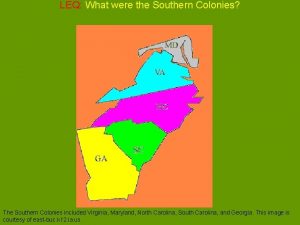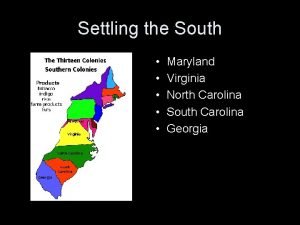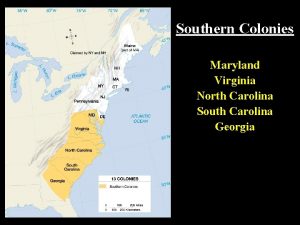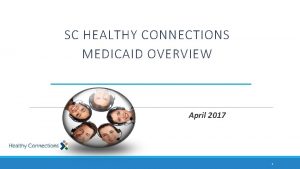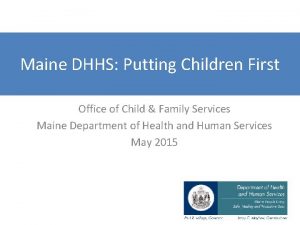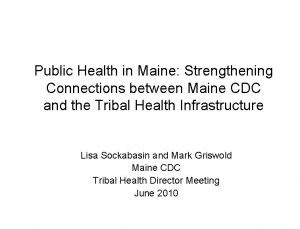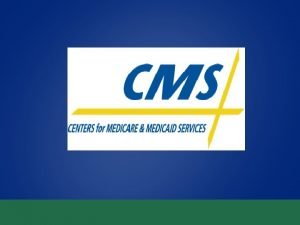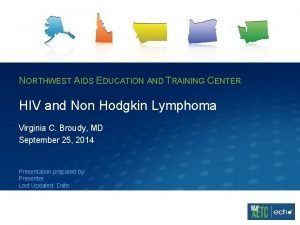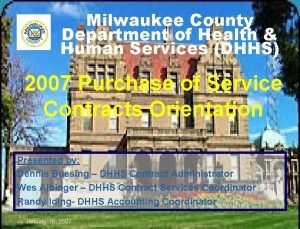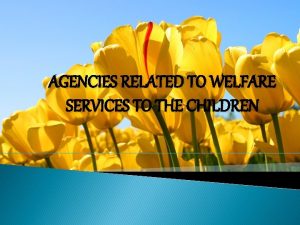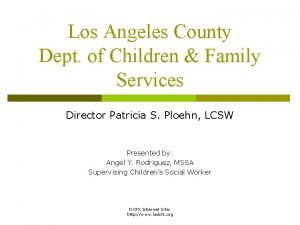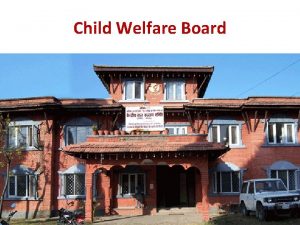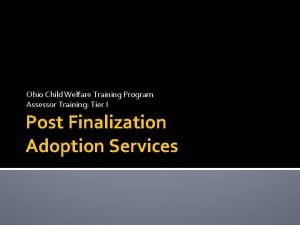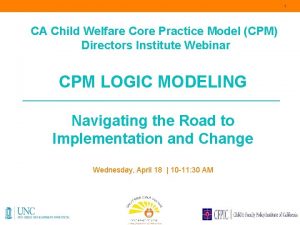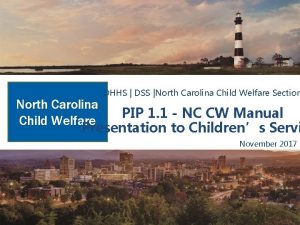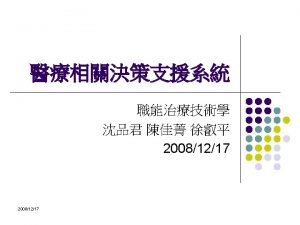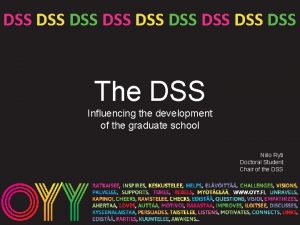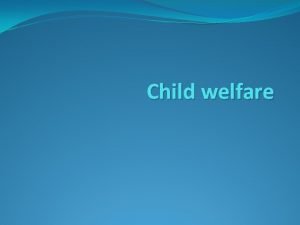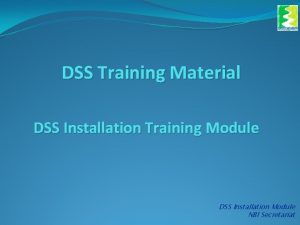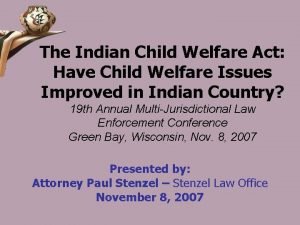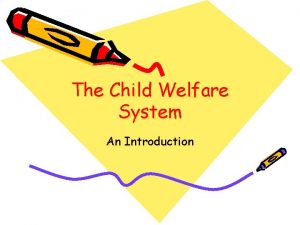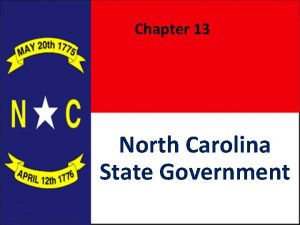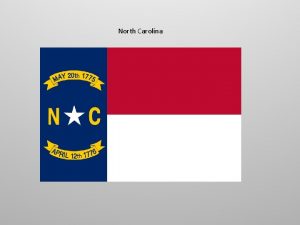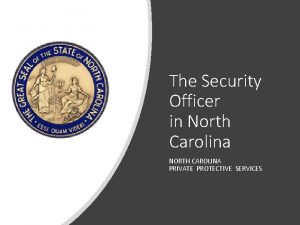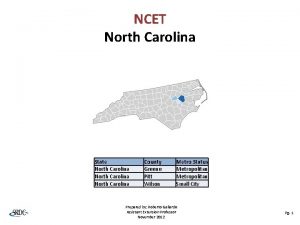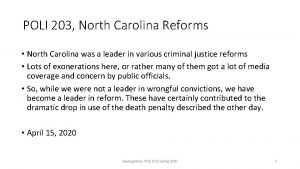DHHS DSS North Carolina Child Welfare Section North





















- Slides: 21

DHHS | DSS |North Carolina Child Welfare Section North Carolina PIP 1. 1 - NC CW Manual Child Welfare Presentation to Children’s Servi November 2017

PIP Goal 1, Strategy 1: Strengthen and clarify NC's child welfare policies and practices Goal: Ensure the NC CW manual supports SAFETY, PERMANENCY and WELL-BEING of CHILDREN. 2

PIP Goal 1, Strategy 1: Strengthen and clarify NC's child welfare policies and practices Achieved through changes in the NC CW Manual ØContent - New and/or modified to: üaddress GAPS to comply with OSRI & to achieve desired outcomes üprovide CLARITY ØOrganization, format and terminology to be: CONSISTENT, CONCISE, and COMPREHENSIVE 3

NC PIP Policy Workgroup Policy workgroup started in Oct. 2016 Representatives from 10 counties (5 pilot and 5 non-pilot counties) Task: 1. Review, assess, revise & publish policy & practice for pilot 2. Pilot of modified policy & practice 3. Statewide implementation of revised policy Complete By: Sept. 2017 Dec. 2017 Sept. 2018 Pilot Counties: Buncombe, Craven, Cumberland, Durham, Hoke, Mecklenburg, Pitt, Scotland, Wake and Wilson 4

Framework Purpose and philosophies – overriding vision and principles for North Carolina, Example: Family Centered Practice, Principles of Partnership, & System of Care Policy Protocol Formal, brief statement of requirement(s) that tie directly to federal law and NC Statute and Rules Mandatory action(s) to meet policy requirement(s); Must do requirements Guidance Practice or process guidelines, includes preferred practice and recommended practice guidance Instructions Step-by-step details for performing the specific tasks or forms 5

The Terminology…. Old NEW Policy and Protocol Practice Guidance Shall, must, is required Must (in Policy and Protocol) Should, recommended Should (in Guidance) 6

Manual Format • Sections formatted to clearly differentiate between policy, protocol, and guidance • Shortened sections • Increased use of bullets (less narrative) especially in Protocol • Links – to other sections of the manual • Information that applies to more than 1 function will be in 1 place (Cross Function Topics) 7

Future Manual Organization Vision and Philosophy Principles of Partnership, Core Beliefs, Systems of Care, NC CW Administration Functional Areas Prevention Protective Services Intake Assessments In-Home Placement Adoption Licensing Cross Function Topics 8

What’s in the Pilot Manual? Functional Areas • Protective Services § Intake § Assessments § In-Home • Permanency Planning Cross Function Topics Safety Diligent Efforts CFTs Temporary Safety Providers & Kinship Providers • Filing a Petition • Preparing for Placement • Domestic Violence • • 9 • Risk & Use of Assessment Tools • Collateral Contacts • Parent Engagement • Identifying & Engaging Extended Family • Documentation • MEPA/ICWA

Organization & Format Changes In-Home Manual – Contacts 10 PROTOCOL GUIDANCE INITIAL FAMILY/CHILD CONTACT Within seven days of case decision (Substantiation or a finding of Services Needed for any report of abuse, neglect, and/or dependency), face to face contact with the family by a county child welfare worker must occur. This contact: Begins the transition from the CPS Assessment to CPS In-Home Services; Informs the parent(s) or caretaker(s) of the reason and purpose for In-Home Services; Discusses all safety and risk concerns and the current safety plan (TSPA); and Includes discussion about the development of the In. Home Family Services Agreement within 30 days of the case decision. Documentation of the diligent efforts made and/or rationale for the delay are required if this 7 -day contact does not occur. INITIAL FAMILY/CHILD CONTACT The initial 7 -day face-to-face contact with the family should be completed by the In-Home Services social worker and should also include the CPS assessment worker. The 7 -day contact should occur in the family home and include all members of the family.

Organization & Format Changes Cross Function Topics - Diligent Efforts PROTOCOL Protocol / Standards Diligent efforts to locate must be performed to: Locate alleged victim children; Locate parents, including a noncustodial parent; and Locate the family residence. Diligent efforts shall include, but are not limited to: Visits to the child's or parent’s address at different times of the day and on different days; Attempts to call last known phone number(s); Searches on Accurint, ASSIST or equivalent; 11 GUIDANCE To locate a parent that is in prison, contact the NC Department of Corrections Records Office. Contact numbers and addresses for specific prisons can be found on the NC Division of Prisons website http: //www. doc. state. nc. us/dop/index. htm. All inmates have a case manager or social worker that can assist in contacting a prisoner.

Manual Content • Identified gaps in policy and protocol • Eliminated redundant, repeated, & inconsistent policies in the manual • Added to & clarified policy and protocol that were not well defined • Incorporate Administrative Letters into NC CW manual (not part of the pilot but before statewide implementation) 12

Content to Improve Safety, Permanency & Comply with the OSRI • Contact with Children –Family Assessment & In-Home Services–requirement to interview child separate from caregiver –Contact with children within 3 calendar days of initial placement (in addition to contact on day of placement) • Home Visits –Assessments-Home visit must occur the same day the victim child is seen –In-Home-At least one contact per month with each child must be in the home in which he or she resides (New In-Home Services Home Visit Record developed) 13

Content to Improve Safety, Permanency & Comply with the OSRI • Case Staffing & Two Tier Decision Making –Staffing frequency • Every other week during assessments, • Twice a month the 1 st 3 months of all In-Home, • Twice a month the 1 st year of permanency planning, • Whenever there is a change in circumstance that impacts safety or risk to a child(ren) –Defined case staffing vs. supervision 14

New or Modified Forms • Assessments – Modified 5010 • In-Home –Modified Family Services Agreement –In-Home Services Home Visit Record – New form • Permanency Planning –Streamlined PPAT, FSA & CFT forms and timeframes –Visitation Form Family Time Form (family friendly form) • CFTs –New CFT planning form –New CFT meeting form (for meetings not associated with a FSA) • Diligent Efforts – New form 15

Location of Modified Manual The NC CW Modified Manual is available on the NC Child Welfare Technical Assistance website, specifically on the Knowledgebase: https: //nccwta. org/index. php? /Knowledgebase/List The Knowledgebase is accessible to all staff. 16

1 7 Pilot Feedback Positive Feedback & Learnings • Staff can easily find information • Clarity between what MUST occur and what SHOULD occur • Use of Cross Function Topics reduced redundancy • Changes in requirements “make sense” to achieve safety and permanency but require more time • Providing the manual and forms to counties prior to the presentations and implementation facilitated staff input and buy-in • Implementation of the pilot allowed for manual and form improvements prior to state implementation

1 8 Pilot Feedback Concerns & Issues • Staff capacity (time) to meet modified protocol with existing caseloads and other changes across the state • Need to address integration with other statewide changes

1 9 Still to be Completed • Remaining portions of the Manual (Adoptions, Licensing, ICPC, Jurisdiction, Administration, Funding, etc. ) • Conventions throughout the Manual • Process to update and maintain the Manual

Questions? Feedback? 20

Thank you for your participation today. 21
 Virginia, maryland, north carolina, south carolina, georgia
Virginia, maryland, north carolina, south carolina, georgia Map of north carolina and south carolina
Map of north carolina and south carolina Maryland virginia north and south carolina and georgia
Maryland virginia north and south carolina and georgia Virginia, maryland, north carolina, south carolina, georgia
Virginia, maryland, north carolina, south carolina, georgia Rowan county dept of social services
Rowan county dept of social services Dhhs form 3400-a
Dhhs form 3400-a Dhhs portland maine
Dhhs portland maine Maine dhhs districts
Maine dhhs districts Cms headquarters
Cms headquarters Dhhs epoch
Dhhs epoch Milwaukee county health and human services
Milwaukee county health and human services Rids dhhs
Rids dhhs National child health program in india
National child health program in india National child policy 1974
National child policy 1974 Agency related to child welfare
Agency related to child welfare National child welfare agencies
National child welfare agencies Child welfare services
Child welfare services Central child welfare board
Central child welfare board Ohio child welfare training program
Ohio child welfare training program Child welfare
Child welfare Vr3 child welfare foundation
Vr3 child welfare foundation Core practice model
Core practice model

